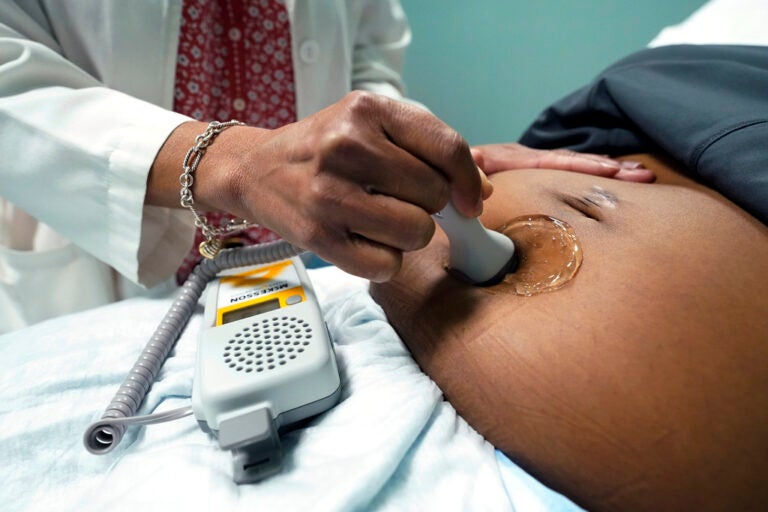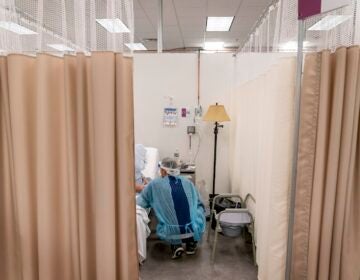New study shows that Black mothers in New Jersey were more likely to deliver babies by unscheduled C-section
Black women were 20% more likely than white women to get an unscheduled, unplanned C-section delivery when there were no high medical risks.
Listen 1:17
FILE - A doctor uses a hand-held Doppler probe on a pregnant woman to measure the heartbeat of the fetus, Dec. 17, 2021, in Jackson, Miss. (AP Photo/Rogelio V. Solis, File)
From Philly and the Pa. suburbs to South Jersey and Delaware, what would you like WHYY News to cover? Let us know!
A study of nearly one million births over a nine-year period in New Jersey found that Black mothers were 20% to 25% percent more likely than white mothers to deliver their babies by an unplanned, unscheduled Cesarean section, a surgical procedure.
Researchers and public health officials say they’re working to identify what’s driving this racial disparity in delivery methods and find ways to close the gap.
“The availability of this data is critical to setting an accurate benchmark … and achieving our goal to make New Jersey the safest and most equitable state to deliver and raise a baby,” New Jersey first lady Tammy Murphy said in a statement.
The study, published by the National Bureau of Economic Research, looked at medical histories and birth records from 2008 to 2017 across 68 hospitals in the Garden State.
Co-author and researcher Molly Schnell, an associate professor of economics at Northwestern University, said this data was extremely detailed and comprehensive.
“We can basically see whether or not Black mothers are more likely to have C-sections because they have risk factors that make them better candidates for the procedure,” she said.
The data showed that Black mothers were 25% more likely to have an unscheduled C-section compared to white mothers overall, including for reasons like health risks and medical complications.
But then, researchers controlled for factors that make C-section delivery more likely for any woman, including high-risk health conditions; a woman’s history of a previous C-section delivery; socioeconomic status; and individual hospitals and doctors that consistently perform higher numbers of surgical deliveries.
They were then left with a population of low-risk mothers who were seemingly healthy and of similar socioeconomic statuses and prior birth histories, with doctors and facilities that did similar numbers of C-section deliveries.
And still, Black women were 20% more likely to get an unplanned C-section compared to white patients, according to the study.
“What this is showing is that even when patients are arriving with similar medical histories, they’re still receiving different treatment,” Schnell said.
Schnell said that left researchers looking at physician discretion as a contributing factor to racial disparities in delivery methods.
“And I think it’s really an open question then of what is driving physicians to essentially be more likely to do this procedure for Black mothers,” she said.
Schnell said reasons could include breakdowns in communication, patients not being fully informed about all their delivery options, or patients feeling like they can’t advocate for the delivery method they’d prefer.
“It could also be something that maybe doctors know that there is evidence of worse birth outcomes for Black mothers,” she said, “and so they just want to make sure to always go to the means necessary to make sure that Black mothers are receiving sort of the most care.”
However, “the most care,” in this case, C-sections, carries a slightly higher risk of complications during and after surgery compared to a vaginal delivery, which is often recommended for low-risk healthy women.
Schnell said hospital groups in New Jersey are interested in using the data to inform their labor and delivery policies, especially when it comes to addressing racial disparities in delivery methods.
“Our goal here isn’t to pit patients against providers. I think our results can really say, though, is that everyone has a role to play,” Schnell said. “So that means medical providers also have a role to play in terms of working toward this common goal of reducing racial disparities in terms of health outcomes.”

Get daily updates from WHYY News!
WHYY is your source for fact-based, in-depth journalism and information. As a nonprofit organization, we rely on financial support from readers like you. Please give today.





